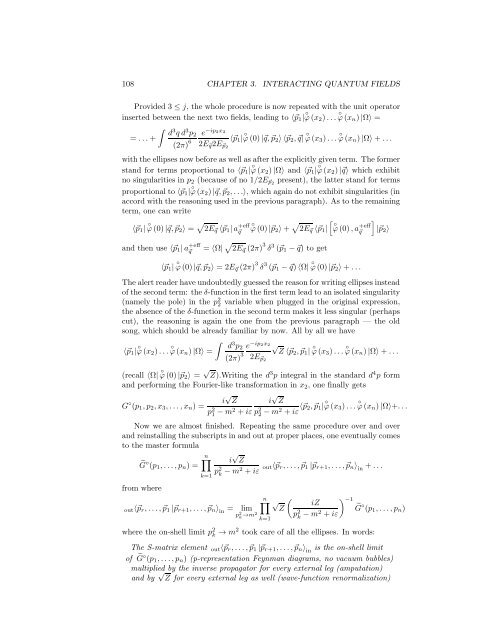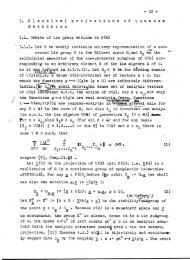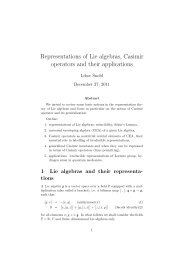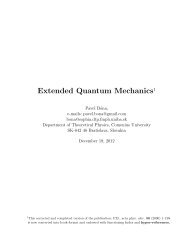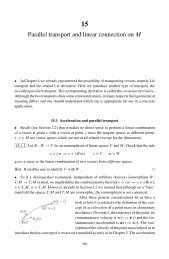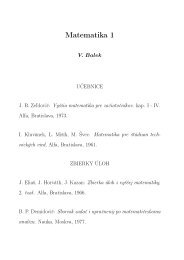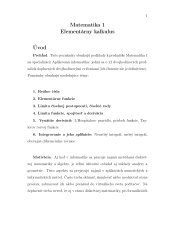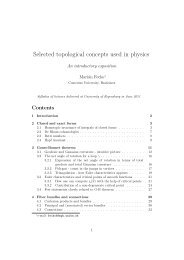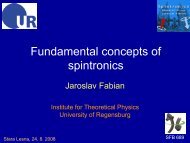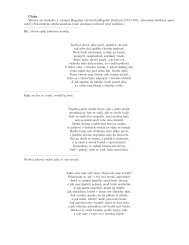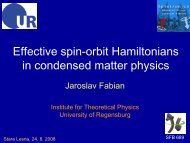Quantum Field Theory I
Quantum Field Theory I
Quantum Field Theory I
You also want an ePaper? Increase the reach of your titles
YUMPU automatically turns print PDFs into web optimized ePapers that Google loves.
108 CHAPTER 3. INTERACTING QUANTUM FIELDS<br />
Provided 3 ≤ j, the whole procedure is now repeated with the unit operator<br />
inserted between the next two fields, leading to 〈⃗p 1 | ϕ(x ◦ 2 )... ϕ(x ◦ n )|Ω〉 =<br />
∫ d 3 qd 3 p 2 e −ip2x2<br />
= ...+<br />
(2π) 6 〈⃗p 1 | ϕ(0)|⃗q,⃗p ◦ 2 〉〈⃗p 2 ,⃗q| ϕ(x ◦ 3 )... ϕ(x ◦ n )|Ω〉+...<br />
2E ⃗q 2E ⃗p2<br />
withthe ellipsesnowbeforeaswellasaftertheexplicitlygiventerm. Theformer<br />
stand for terms proportional to 〈⃗p 1 | ϕ(x ◦ 2 )|Ω〉 and 〈⃗p 1 | ϕ(x ◦ 2 )|⃗q〉 which exhibit<br />
no singularities in p 2 (because of no 1/2E ⃗p2 present), the latter stand for terms<br />
proportional to 〈⃗p 1 | ϕ(x ◦ 2 )|⃗q,⃗p 2 ,...〉, which again do not exhibit singularities (in<br />
accord with the reasoning used in the previous paragraph). As to the remaining<br />
term, one can write<br />
〈⃗p 1 | ϕ(0)|⃗q,⃗p ◦ 2 〉 = √ 2E ⃗q 〈⃗p 1 |a +eff ◦<br />
⃗q<br />
ϕ(0)|⃗p 2 〉+ √ 2E ⃗q 〈⃗p 1 |<br />
and then use 〈⃗p 1 |a +eff<br />
⃗q<br />
= 〈Ω| √ 2E ⃗q (2π) 3 δ 3 (⃗p 1 −⃗q) to get<br />
[ ◦ϕ(0),a<br />
]<br />
+eff<br />
⃗q<br />
|⃗p 2 〉<br />
〈⃗p 1 | ◦ ϕ(0)|⃗q,⃗p 2 〉 = 2E ⃗q (2π) 3 δ 3 (⃗p 1 −⃗q)〈Ω| ◦ ϕ(0)|⃗p 2 〉+...<br />
Thealertreaderhaveundoubtedlyguessedthe reasonforwritingellipsesinstead<br />
ofthe secondterm: theδ-function in thefirstterm leadtoanisolatedsingularity<br />
(namely the pole) in the p 2 2 variable when plugged in the original expression,<br />
the absence of the δ-function in the second term makes it less singular (perhaps<br />
cut), the reasoning is again the one from the previous paragraph — the old<br />
song, which should be already familiar by now. All by all we have<br />
∫<br />
〈⃗p 1 | ϕ(x ◦ 2 )... ϕ(x ◦ d 3 p 2 e −ip2x2 √<br />
n )|Ω〉 =<br />
(2π) 3 Z〈⃗p2 ,⃗p 1 | ϕ(x ◦ 3 )... ϕ(x ◦ n )|Ω〉+...<br />
2E ⃗p2<br />
(recall 〈Ω| ◦ ϕ(0)|⃗p 2 〉 = √ Z).Writing the d 3 p integral in the standard d 4 p form<br />
and performing the Fourier-like transformation in x 2 , one finally gets<br />
G ◦ i √ Z i √ Z<br />
(p 1 ,p 2 ,x 3 ,...,x n ) =<br />
p 2 1 −m2 +iεp 2 2 −m2 +iε 〈⃗p 2,⃗p 1 | ϕ(x ◦ 3 )... ϕ(x ◦ n )|Ω〉+...<br />
Now we are almost finished. Repeating the same procedure over and over<br />
and reinstalling the subscripts in and out at proper places, one eventually comes<br />
to the master formula<br />
˜G ◦ (p 1 ,...,p n ) =<br />
from where<br />
n∏<br />
k=1<br />
∏<br />
n<br />
out〈⃗p r ,...,⃗p 1 |⃗p r+1 ,...,⃗p n 〉 in<br />
= lim<br />
p 2 k →m2<br />
i √ Z<br />
p 2 k −m2 +iε out 〈⃗p r ,...,⃗p 1 |⃗p r+1 ,...,⃗p n 〉 in<br />
+...<br />
k=1<br />
√<br />
Z<br />
(<br />
) −1<br />
iZ ˜G◦ p 2 (p 1 ,...,p n )<br />
k −m2 +iε<br />
where the on-shell limit p 2 k → m2 took care of all the ellipses. In words:<br />
The S-matrix element out 〈⃗p r ,...,⃗p 1 |⃗p r+1 ,...,⃗p n 〉 in<br />
is the on-shell limit<br />
of ˜G◦ (p 1 ,...,p n ) (p-representation Feynman diagrams, no vacuum bubbles)<br />
multiplied by the inverse propagator for every external leg (amputation)<br />
and by √ Z for every external leg as well (wave-function renormalization)


